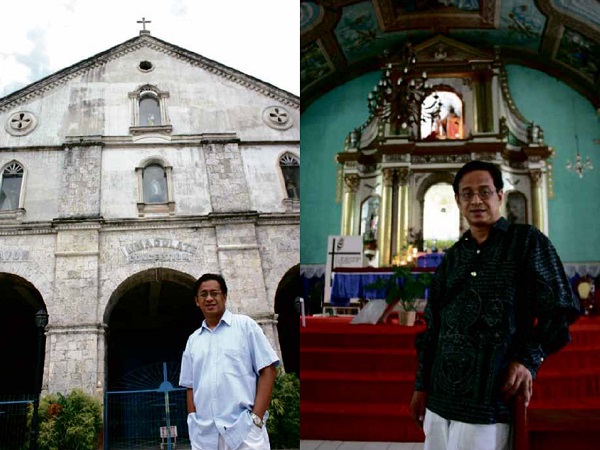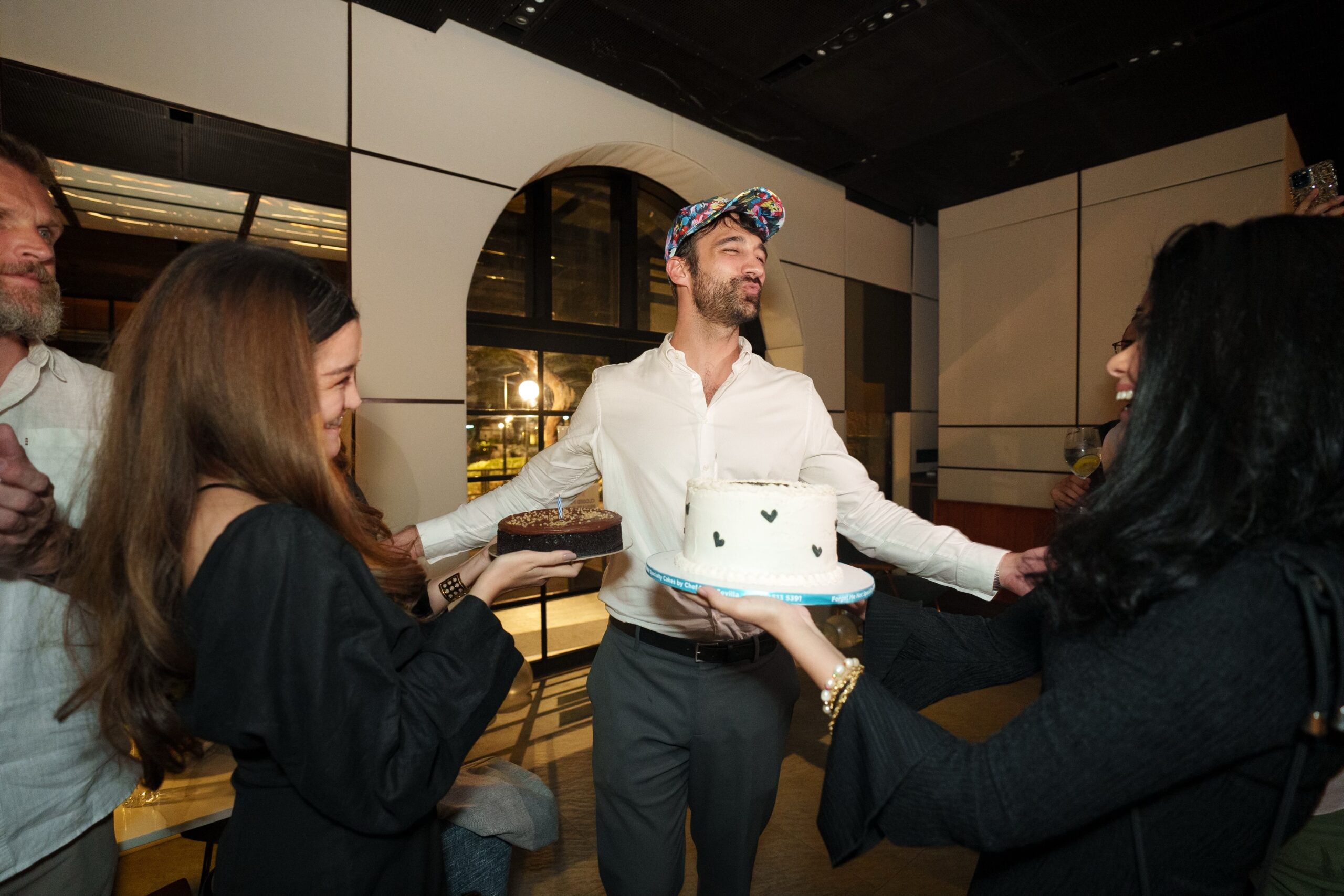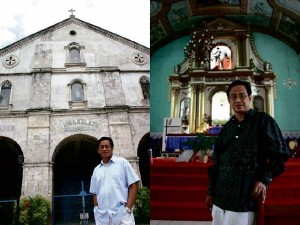
people’s innate artistry, our determination to build structures for our faith, our creative adaptation to our climate and our sense of history.”
It was 6 a.m. in Dubai when Lutgardo “Gardy” Labad first heard the worrying news. He was up early to prepare for a drama workshop he was conducting for the OFW community there. A cousin of his texted that a strong earthquake had struck Bohol, and that the floor in their ancestral house had cracked.
“I rushed to Facebook and and saw the first pictures of the devastation—first, Loboc Church, then Baclayon, Maribojoc, Loon, all pulverized to the ground. I wept. It is not only the damage to physical structures that was devastating. It’s the damage to the soul and heart—our history, our values, our heritage,” said Labad.
“The years of conservation work, all gone to naught,” he added. “The work of national cultural agencies, especially the efforts of Fr. Ted Torralba, who facilitated the documentation of our ecclesiastical heritage, leading to their declaration as national landmarks and national cultural treasures. So much beauty, so much artistic magnificence wiped out in an instant.”
Tireless advocate
Labad has long been a tireless advocate for the preservation of Bol-anon culture and heritage. A noted musical composer and theater artist, he has directed most of his energies in the last few years helping develop the tourism programs of his home province, centering on its buffet of cultural treasures from historic, well-preserved churches to native food, crafts, music, dance and entertainment harnessed for eco-cultural activities such as the Abatan River Community Life Tour.
“We wanted to get back home as swiftly as we could, but we were prevailed upon to stay because we needed to accomplish our commitments to the Filipino community here in Dubai,” said Labad in an e-mail.
He has used the power of social media to appeal for help, not only for emergency supplies for those affected by the quake, but also for the sites of the centuries-old churches and other damaged heritage buildings to be kept secure, to allow cultural workers enough time and space to assess the damage and collect important remnants.
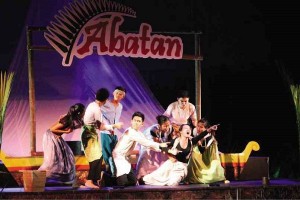
“Let’s do a program for trauma and site assessment,” he exhorted at one point. “This can be a defining moment for all of us. The destruction revealed the level of fragility and vulnerability of our ecology and culture. We need to unite our ranks to address these challenges.”
Life-changing event
Labad’s life has centered on the arts, from his childhood when his grandfather and mother taught him to play the piano. High school at the seminary found him directing excerpts of plays for the school.
Then, in the summer of 1968, came a life-changing event. The teenaged Labad read an announcement in the papers that the Philippine Educational Theater Association (Peta), which had been founded the previous year by Cecile Guidote, had a training program. And so he enrolled in Peta’s Teen Theater and had Guidote herself as his teacher.
“It was a mind-blowing experience,” he recalled. “Cecile opened my mind to the endless possibilities of creative theater. I was enchanted by the space dynamics of the Fort Santiago theater. Our summer showcase displayed the imaginative potential of improvisation.”
He got to know Anton Juan, Tony Perez, Nonon Padilla, Vic Silayan, Adul de Leon, the Peta Kalinangan Ensemble, and saw their works. “I was incurably bewitched,” he said.
True calling
What Labad had learned at Peta he applied at the seminary—to the shock of his teachers. Soon he dropped his seminary garb and rushed to Peta for further training. He had found his true calling in life.
“I was under the tutelage of my stage mother, Cecile… I learned from her the concept of the national theater movement, the repertory theater ensemble, the artist-teacher-leader vocation, the aesthetics of original drama done in the vernacular, and all that Peta has stood for all of these decades—theater as art and public service,” he said.
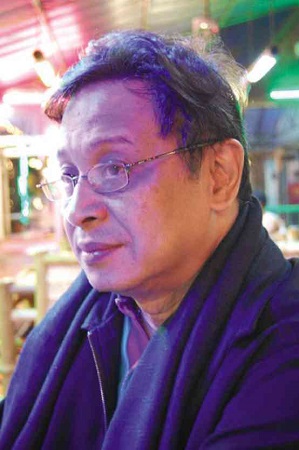
While being trained as a theater artist, Labad was taking electives in music at UP Diliman and studying Mass Communications. With that background, for many years he served as composer and stage director for Peta. The first full-length sarsuwela he composed was “Halimaw,” written by Isagani Cruz and directed by Nonon Padilla.
Significant plays he directed include the iconic “Hanggang Dito na Lamang at Maraming Salamat,” with Lino Brocka and Bembol Roco, performed nearly a hundred times in Fort Santiago; “May I-May I,” by Emman Lacaba; and “Nasa Puso ang Amerika” by Bien Lumbera and Jovenal Velasco, an adaptation of Carlos Bulosan’s classic personal history, “America Is in the Heart,” about the hardships migrants faced during the Great Depression of the 1930s.
Later Labad scored for films, including memorable ones like “Tinimbang Ka Ngunit Kulang,” “Ganito Kami Noon, Paano Kayo Ngayon” and “Independencia.”
Unique touch
In the last 15 years, he has been an active member of the National Commission for Culture and the Arts, immersing himself in cultural activities in Bohol while also networking with Asian artists.
The Abatan River Community Life Tour, which brings visitors and tourists on a leisurely cruise of Bohol’s third largest river, has a uniquely Labad touch, if you will: Five coastal municipalities along the way—Maribojoc, Antequera, Balilihan, Cortes and Catigbian—welcome visitors with festivities showcasing each town’s native food, crafts, history and heritage. In Antequera, a homegrown theater group made up mostly of young theater actors perform an excerpt from an original musical play about Bol-anon folk hero Tamblot. They are proud students and protégés of Labad.
“My life in music, drama and film reveals the interconnectedness of these three as an organic process of artistry and culture-building,” he said. “It proves to me the power of the arts to express the nation’s dreams and cultural identity, to mirror truth and reality, to foment change and transformation.”
“There is a continuing need to galvanize and ‘dynamize’ arts and culture as an instrument for less privileged groups to raise the quality of life and to develop community-based creative industries,” he added.
Enough of tears
Now that his beloved Bohol has been dealt a body blow, Labad is refusing to wallow in misery.
“Enough of tears. Bohol will rise, but not until people really value what is most essential to our lives, until we all value our past and its positive gifts,” he said.
“Perhaps it can be a fresh start for us. Tourism profits have not really spread out to the more disadvantaged sectors in the province. Some investors and businessmen have been exploiting our natural resources without thinking of the carrying capacity of the environment and without being sensitive to the basic needs of communities,” he added.
At this crossroads, he proposes a new road map for Bohol: “Let us secure our cultural heritage in a more proactive, more solid manner. Let us prepare a stronger disaster management plan in the face of our vulnerable ecology and fragile relics. Let us organize people’s cultural organizations to safeguard our legacy. Let us see to it that the people’s resources are used in the right way. Let us take environmental and cultural preservation and conservation more seriously as a people, not just because it is important for livelihood and tourism, but more essentially, because it helps strengthen our faith, identity and sources of life.”
How to help Bohol
FOR ASSISTANCE in Bohol’s heritage rehabilitation work, please direct inquiries and aid to Fr. Ted Torralba at 0917-3040103 or Fr. Val Pinlac at 0917-6209988. For relief aid, please contact the following: for Loon, Reigh Monreal 0919-4842779; for Maribojoc, 0920-7495843 (Maryanne Jabines) or 0928-5078279 (Mayor Jun Evasco); for Baclayon, 0926-2055360 (Lovely Mayor’s office); for Loboc, 0946-1722194 (Nerea Jimenez of the Loboc Children’s Choir); or call the landline of the Governor’s Mansion 038-4113573.

